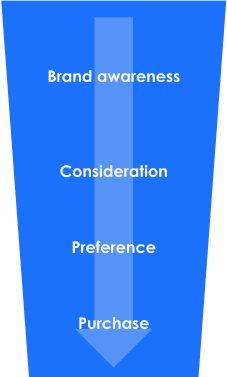
Even if you don’t know the term, you’ve definitely seen digital display advertising - probably multiple times already today. In its most common form, it’s all those boxes and banners you see smattered across almost every website on the internet.
Many of these ads will beg you to ‘find out more’ or ‘click here’. But of course you won’t; few people do. The average click-through rate (the ratio of clicks on an ad to the total number of people who have seen it) for an online display ad is just 0.05%.
Yet for many years, clicks and click-through rates have been used as the primary metric for understanding the effectiveness of online advertising. It seems like a hard sell. Indeed, if other mediums, such as email, outperform digital display ads in click-through rate, it may seem like a no-brainer. But, if 60% of SMEs still use paid digital advertising, there must be more to it.
When developing our self-service ad platform, we found that a common and frustrating issue advertisers had was with performance being solely judged by click-through rate.
Thankfully, the industry has started to wake up to this too. In 2019, the Internet Advertising Bureau UK (IAB) declared a National Anti-Click-Through Rate Day, with the memorable tagline ‘Don’t be a clickhead’. The IAB argue (and we agree) that conducting brand studies - measuring the holistic impact of your advertising on your business’s name recognition and reputation - should be advertisers’ new priority.
Click-centric campaign measurement has ended up missing most of the actual effects of digital advertising. This is because it ignores the marketing funnel - the journey a customer makes in 4 stages towards a sale.

This journey starts with customers’ becoming aware of your company when they first hear about it; then they consider whether they are interested in what you sell. Eventually those customers will prefer your business over your competitors, before finally taking action with a purchase.
Click-through rate doesn’t map onto any of these stages, telling you very little about whether you’re achieving results in any of them. Display advertising’s real strength lies in getting people into the top of the funnel: generating awareness of your business. You can then build your brand through repeated exposure and clever retargeting.
Let’s be honest - you probably don’t remember the last ad you clicked on, but you probably do remember seeing advertising from various specific brands whose marketing you can recognise instantly.
Here are just a few ways of understanding the real effectiveness of online advertising across each stage of the funnel, and how it builds your brand in ways clicks could never tell you.
There are a few company logos that almost everyone on Earth is familiar with - McDonalds, Coca Cola, Ikea, Google, Nike, Apple, Microsoft.
These graphics are part of the fabric of our lives, and many of us will see several in the space of a day, from putting our shoes on in the morning to turning off our iPhones at night.
Their instant recognisability is a result of a whole mix of factors - great design, longevity, mass production, market capture and effective saturation.
Of course, some of these factors aren’t really relevant or achievable for some of the largest companies in the UK, let alone a small or local business. But whatever your size, a great logo remains a deeply powerful asset that speaks for itself.
Online advertising allows you to serve your logo at scale to a targeted audience, eventually imprinting it in people’s heads. Clicks really don’t matter in this context - what matters is getting the logo seen by the right audience in the right place.
Hosting your advertising in quality environments like your local news website is proven to boost its effect on brand awareness by over 10%. Check out how to get your ads up and running in a place people will pay attention.
Decent display advertising should give people an instant impression of your business as a brand: not just who you are and what you sell, but your core qualities, quirks and values too.
Rather than dispassionately informing people that you exist, your advertising should communicate something essential about you; something that makes you qualitatively different from competitors.
All the elements of your branding - your colour scheme, your tone of voice, your use of imagery - must cohere within a small space to communicate exactly what you want to put across about yourself. Even more importantly, your branding must be used consistently from one campaign to the next, building and reinforcing recognition over time.
It’s very hard to make a big impact on a viewer from a single exposure. Repeatedly putting your material in front of your target audience in a premium context, across a number of campaigns, is the only way to get those essential messages across. Eventually, people won’t just be thinking about who your business is; they’ll already know, and will have moved on to wondering what you could do for them and whether to give you a try.
Name recognition is a factor in advertising that we’d most naturally associate with the top of the funnel; making people aware of your brand as a prelude to their journey towards a sale.
However, this fundamental task of marketing is hugely important at later stages of the funnel too. While people do make impulse or emergency purchases from businesses they’ve not previously heard of, it’s not that common.
As mobile marketing guru Larry Kim writes, “The single biggest predictor of whether people will purchase is whether they've heard of you before.” A brand awareness campaign, targeted at a responsive audience, lays the vital groundwork of name recall that you can then build on with a campaign on a more sales-oriented platform like Google Ads.
Whatever your click rate, a brand awareness campaign creates the conditions that make people more likely to go through the whole sales funnel (and back down it again later).
It’s not even as if turning your attention away from clicks will leave you without tangible data on how your ads are performing. It’s now possible and affordable for businesses of all sizes to prove the value of their awareness campaigns with brand studies.
Until recently, brand studies were not a realistic option for most SMEs, with the likes of Facebook only offering them for campaigns over £20K in ad spend. However, we now offer a comprehensive brand study as standard to our advertising partners, courtesy of our independent analytics providers Brand Metrics. Making that vital brand lift data accessible to everyone, with more marketers than ever able to answer that crucial question, “did my campaign work?”.
Whatever your click rate actually is, don’t get too hung up on it. There’s so much more happening when you get your brand out there than simple taps of the mouse button. You’re embedding your name and visual identity in people’s heads, making them think through what you offer and pushing them closer to the cash register.
For more advice on understanding the real effectiveness of online advertising, check out some more of our content